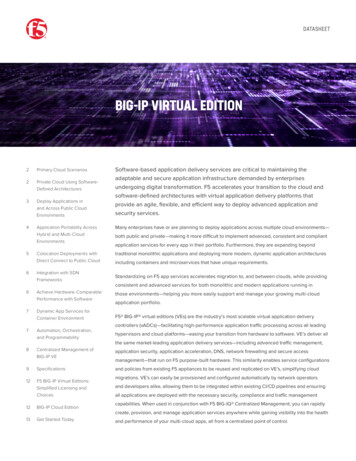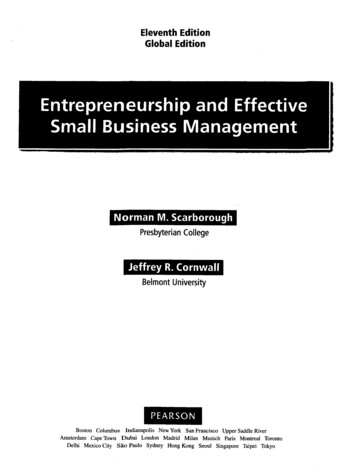
Transcription
DATASHEETBIG-IP VIRTUAL EDITION2 Primary Cloud Scenarios2 Private Cloud Using SoftwareDefined Architectures3 Deploy Applications inand Across Public CloudEnvironmentsSoftware-based application delivery services are critical to maintaining theadaptable and secure application infrastructure demanded by enterprisesundergoing digital transformation. F5 accelerates your transition to the cloud andsoftware-defined architectures with virtual application delivery platforms thatprovide an agile, flexible, and efficient way to deploy advanced application andsecurity services.4 Application Portability AcrossHybrid and Multi-CloudEnvironmentsMany enterprises have or are planning to deploy applications across multiple cloud environments—5 Colocation Deployments withDirect Connect to Public Cloudtraditional monolithic applications and deploying more modern, dynamic application architecturesboth public and private—making it more difficult to implement advanced, consistent and compliantapplication services for every app in their portfolio. Furthermore, they are expanding beyondincluding containers and microservices that have unique requirements.6 Integration with SDNFrameworksStandardizing on F5 app services accelerates migration to, and between clouds, while providing6 Achieve Hardware-ComparablePerformance with Softwarethose environments—helping you more easily support and manage your growing multi-cloud7 Dynamic App Services forContainer EnvironmentF5 BIG-IP virtual editions (VEs) are the industry’s most scalable virtual application delivery7 Automation, Orchestration,and Programmabilityconsistent and advanced services for both monolithic and modern applications running inapplication portfolio.controllers (vADCs)—facilitating high-performance application traffic processing across all leadinghypervisors and cloud platforms—easing your transition from hardware to software. VE’s deliver allthe same market-leading application delivery services—including advanced traffic management,8 Centralized Management ofBIG-IP VEapplication security, application acceleration, DNS, network firewalling and secure access9 Specificationsand policies from existing F5 appliances to be reused and replicated on VE’s, simplifying cloud12 F5 BIG-IP Virtual Editions:Simplified Licensing andChoices12 BIG-IP Cloud Edition13 Get Started Todaymanagement—that run on F5 purpose-built hardware. This similarity enables service configurationsmigrations. VE’s can easily be provisioned and configured automatically by network operatorsand developers alike, allowing them to be integrated within existing CI/CD pipelines and ensuringall applications are deployed with the necessary security, compliance and traffic managementcapabilities. When used in conjunction with F5 BIG-IQ Centralized Management, you can rapidlycreate, provision, and manage application services anywhere while gaining visibility into the healthand performance of your multi-cloud apps, all from a centralized point of control.
AVAILABLE BIG-IP MODULES: BIG-IP Local Traffic Manager (LTM) BIG-IP DNS BIG-IP Advanced FirewallManager (AFM) BIG-IP Access Policy Manager(APM) Advanced WAF SSL Orchestrator BIG-IP Carrier Grade NAT(CGNAT) BIG-IP Policy EnforcementManager (PEM)KEY BENEFITSIncrease multi-cloud agilityQuickly and easily spin up, spin down, or migrateapplication delivery services across the datacenter and public cloud, using instant deploymentoptions as needed.Accelerate deployments with automationAutomate app services insertion with F5’sAutomation Toolchain. It enables declarativeprovisioning and configuration of BIG-IP VEacross cloud environments and integration withautomation and CI/CD tools including Ansible,Jenkins, and Terraform.Optimize application and security servicesImplement robust security and traffic managementservices to keep your apps available, protectedand compliant—regardless of deployment location.Use modern application architecturesNative integration with container orchestrationenvironments lets you implement advanced appservices that are as dynamic as your containers.Support high-performance requirementsin the cloudMake the transition from hardware to softwarewithout the typical performance degradation issues.Gain ultimate deployment and consumptionflexibilityDeploy BIG-IP VE across the broadest array ofsupported hypervisor and cloud platforms withthe freedom to consume through perpetual,utility, subscription, or enterprise licensingagreement (ELA).PRIMARY CLOUD SCENARIOSBIG-IP virtual editions (VEs) can be used to deliver a consistent set of advanced applicationservices in the four primary cloud scenarios described below: private cloud/software-defined datacenter (SDDC), public cloud, multi/hybrid cloud, and colocation with cloud interconnect.PRIVATE CLOUD USING SOFTWARE-DEFINED ARCHITECTURESEnterprises are migrating to private cloud/SDDCs to achieve agility, application time to market,and to provide control to application owners and developers via a self-service portal orcatalog. A private cloud or SDDC using F5 application services is ideal for speeding applicationdeployments, enabling dynamic changes in the data center, and matching infrastructure servicesto workloads using a per-app model. F5 products and solutions integrate with the leading privatecloud technology platforms, including OpenStack, VMware, Cisco, and Microsoft Azure Stack. F5provides cloud solution templates and supports open source tools like Heat, Ansible, and openvm-tools to orchestrate and automate the deployment of app delivery and security services.DATASHEET / BIG-IP VIRTUAL EDITIONS2
Flexibility and high performance in a two-tier hybrid architectureSome enterprises are moving to a two-tier architecture as part of their SDDC transformation. Atthe edge of the network is the application tier that provides front-door services including L4 trafficmanagement, DDoS firewall, or SSL offload—for all traffic entering the network, based on overallbusiness and security policies. Services that deal with high-volume traffic require the highestperformance and scalability, a case where dedicated, purpose-built hardware can be more costefficient than commodity servers. The per-app tier manages the application stack inside the datacenter, which leverages highly scalable, flexible software to deliver advanced application andsecurity services on a per-application basis. This two-tier hybrid data center model (see Figure 1)offers the best of both worlds: hardware where it’s needed and software agility close to the app.PER-APPLICATION SERVICES TIERFigure 1: Two-tier architecture with F5hardware or shared multi-app VE at theedge and per-app VEs.App Layer Traffic Management Advanced Web App FirewallBIG-IPVEAPPLICATION SERVICES TIERSUBSCRIBERSPer-App VEOne Commercial ServerDDoS Protection DNS Access Management/Identity Federation Load Balancing to App StacksApp 1App Layer Traffic Management Advanced Web App FirewallBIG-IPVEBIG-IP PlatformMulti-App( HW Acceleration)VEBIG-IPVEPer-App VEOne Commercial ServerApp 2REST APIApp Layer Traffic Management Advanced Web App FirewallBIG-IPVEBIG-IQOrchestrationand AutomationBIG-IQCentralizedManagementPer-App VEOne Commercial ServerApp NPer-App Dashboard,Reporting, and LicenceManagementDEPLOY APPLICATIONS IN AND ACROSS PUBLIC CLOUD ENVIRONMENTSDeploying applications in the leading public clouds gives you the flexibility and scalability youwant, without the investment and capital costs associated with building out additional privatedata centers. Using F5 application and security services delivered by BIG-IP VEs provides thefollowing benefits: Repeatable architectures across cloud environments—as you expand and adopt newclouds, reuse the same secure, validated, and compliant architecture to accelerate multicloud adoption and simplify operations. Reduced tool sprawl and operational complexity—standardizing on familiar services thatare cloud-agnostic makes deploying and maintaining apps across cloud environmentsquicker and easier.DATASHEET / BIG-IP VIRTUAL EDITIONS3
Consistent levels of availability, performance, and security—provide your customers withan excellent user experience while protecting both your revenue and reputation. Faster time to market—rapidly provision advanced application services when launchingnew applications or migrating existing applications to the public cloud. Deep integration with public cloud providers—dynamically scale out app services throughintegration with AWS Auto Scaling, or easily apply advanced application security with an out-ofthe-box, pre-configured web application firewall (WAF) solution in the Azure Security Center. Flexible licensing models— consume with a licensing model supportive of your businessrequirements, whether that’s as a subscription, enterprise licensing agreement (ELA), payas-you-go, or on a perpetual-basis.CLOUDFigure 2: BIG-IP VE's deployed within anautoscaling architecture—either within oracross availability zones—to ensure thatyour apps are available and secure whileoptimizing costs as your apps scale tomatch demand.AUTOSCALE PVEAPPLICATION PORTABILITY ACROSS HYBRID AND MULTI-CLOUD ENVIRONMENTSDespite the many benefits of public cloud deployments, enterprises often avoid movingall applications or data to the public cloud due to perceived loss of control, risk, regulatorycompliance, and lack of support for legacy application design. As a result, many elect to operatewithin a hybrid cloud or hybrid multi-cloud model whereby part of their operations run in thepublic cloud(s) while components unable to move to the cloud or that require advanced securityand compliance monitoring remain on-premises. In some scenarios, applications operate acrossenvironments to increase redundancy or to allow greater scale-out capacity when needed. F5increases the portability of these apps while reducing management overhead by providing a setof standardized application services that can be reused wherever an app is currently running, orwherever it’s redeployed to. In Figure 3, internet-facing front-end applications are deployed in thepublic cloud while mission-critical workloads with greater security and compliance requirementsrun on-premises. A direct connection links the two environments to reduce latency.DATASHEET / BIG-IP VIRTUAL EDITIONS4
L4-7 SERVICESL4-7 SERVICESVPNBIG-IPVEDirectConnectCOMPUTEFRONT ENDFigure 3: Hybrid cloud deployment withBIG-IP Virtual Editions supporting appsacross public cloud and data center.CLOUDSTORAGEDATA CENTERCOLOCATION DEPLOYMENTS WITH DIRECT CONNECT TO PUBLIC CLOUDMany enterprises operate their application portfolio in a hybrid cloud model similar to that shownin Figure 3. But, for some, there may be an associated latency increase caused by large distancesbetween their data center and cloud edge locations. For these organizations, the best option is todeploy on-premises apps within a colocation facility and use direct connections to connect bothends of their hybrid architecture. F5 BIG-IP VE can also be deployed in these colocation facilitiesand used to provide application service insertion for both apps deployed in the colocation andthose running in the public cloud. As a result, consistent app services can be implemented forapps running in different cloud environments.AWSApp 1App 2AZUREApp NBIG-IPVEVMWARE DATA CENTERAZURE STACK DATA CENTERINTERCONNECT PROVIDERLocal and Global Delivery Network SecurityLocal and Global Delivery Network SecurityApp Delivery Services SSL Access App Security ServicesBIG-IPVEBIG-IPVEInternetApp 1App 2App NBIG-IPVEBIG-IPVEBIG-IPVEDEVICESBIG-IPVEFigure 4: Consistent application services across public cloud, private cloud, data center, and colocation facilities.DATASHEET / BIG-IP VIRTUAL EDITIONS5
INTEGRATION WITH SDN FRAMEWORKSSoftware-defined networking (SDN) achieves agility, flexibility, and cost-efficiency in terms ofovercoming the complexity of networking infrastructure in data centers today. SDN seeks tooperationalize the network through virtualization and abstraction, similar to what has occurredfor servers and storage. However, while SDN has focused on stateless L2–3 connectivity, thereremains the need for stateful and flow-aware L4–7 services. Through its Technology Alliancepartnerships, F5 is completing the SDN vision by integrating its intelligent app delivery serviceswith leading SDN architectures (VMware NSX, Cisco ACI) via BIG-IP plug-ins and REST APIs.In addition, BIG-IP platforms can serve as SDN gateways, bridging virtualized networks andtraditional network architectures to provide a smooth transition and investment protection.ACHIEVE HARDWARE-COMPARABLE PERFORMANCEWITH SOFTWAREA significant inhibitor of cloud adoption among large enterprises and especially service providers, isthe reduction in performance typically associated with a transition from hardware to software. Thismeans that, for many, the promise of increased deployment agility and scalability the cloud offers maynot be worth sacrificing low latency, highly responsive user experiences their data center delivers.The BIG-IP Virtual Edition is the most scalable, high performing virtual ADC available, capable ofsupporting 100Gbps NICs within a single instance, meaning you don’t have to choose betweenagility and high performance—you can have both. Below are a few examples of how BIG-IP VirtualEdition has been augmented to provide even greater performance. High Performance VEs—these VE instances aren’t limited by a throughput cap, but areinstead licensed by the number of vCPU cores that can be allocated. That lets you optimizethe underlying host hardware and achieve 85Gbps of L4 throughput. SR-IOV and Advanced Network Interface Card (NIC) support—BIG-IP VE’s driver isoptimized to interact directly with underlying NIC’s using Single Root I/O Virtualization (SRIOV), significantly improving throughput performance and reducing
data centers. Using F5 application and security services delivered by BIG-IP VEs provides the following benefits: Repeatable architectures across cloud environments —as you expand and adopt new clouds, reuse the same secure, validated, and compliant architecture to accelerate multi-cloud adoption and simplify operations.











